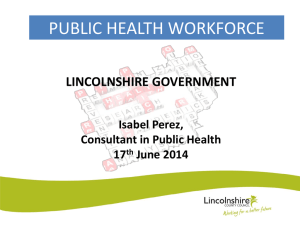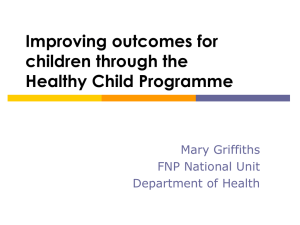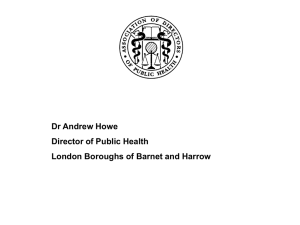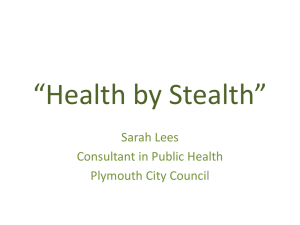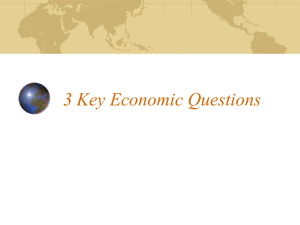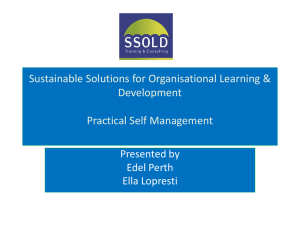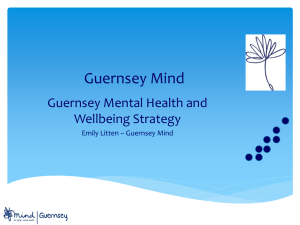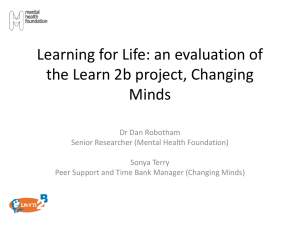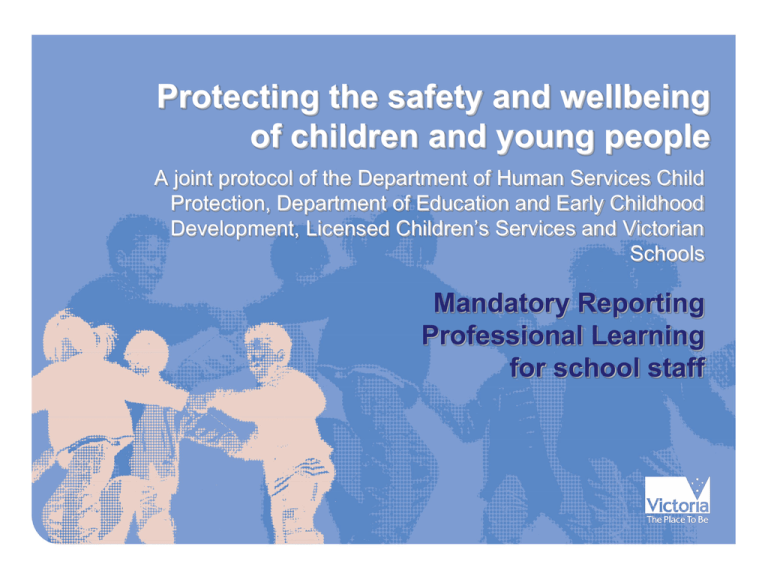
Protecting the safety and wellbeing
of children and young people
A joint protocol of the Department of Human Services Child
Protection, Department of Education and Early Childhood
Development, Licensed Children’s Services and Victorian
Schools
Mandatory Reporting
Professional Learning
for school staff
Today’s training will include information
about……
• Child Protection
– Guiding principles - Legislative and Theoretical Context
• Roles of Agencies
– Child Protection & Child FIRST, DEECD, Police and others
• Reporting
– Mandated - Non-mandated - Forming a belief
• Reporting/Referral arrangements
– Child Protection or Child FIRST
• School responsibilities
– Role – Reporting - Confidentiality
• Information sharing
– Police - Child Protection & Child FIRST - Support agencies
Protecting the safety and wellbeing of children and young people.
Introductory Group Exercise On Monday morning, Michael appears at school with
raised welts across the back of his legs.
When questioned, he says that on Saturday he used
his father’s work computer without permission.
His father became angry and hit him with a belt.
Michael says that, by the end of the weekend
everything was ok between him and his Dad.
What issues does this raise for you?
What influences your view?
Protecting the safety and wellbeing of children and young people.
Influences on our values……
• Our childhood experiences
• Our parenting experiences
• Our educational training
• Our work place culture
• The culture of our family and wider network
• Societal values
Protecting the safety and wellbeing of children and young people.
The Legislative Context
Children Youth and Families Act 2005 (CYFA 2005)
• Passed in 2005
• Came into operation 23 April 2007
• Governs the provision of Child Protection, Family
Services, Out of Home Care, Youth Justice and a
specialist Children’s Court
• Enables and guides the operation of Child FIRST
Protecting the safety and wellbeing of children and young people.
Focus of Legislation and Reforms
• Promotion of Children's Best Interests
– safety, stability and development
• The ‘Best Interests’ of the child are paramount –
– these principles guide all decision making
• Earlier intervention –
– support for vulnerable families via referral to Child FIRST
• Reducing abuse and neglect –
– increased emphasis on preventing cumulative harm (S 162 CYFA (2005))
• Improved quality of care
– for children and young people in out of home care and leaving care
Protecting the safety and wellbeing of children and young people.
Definition of a Child:-CYFA 2005
• Under the Act, a child is defined as under the age
of 17 years
• If a Child Protection Order is in place, the definition
of a child includes those under the age of 18 years
• Reports can also be received about unborn
children.
Protecting the safety and wellbeing of children and young people.
Legal Definition:A Child in Need of Protection
Section 162 of the CYFA 2005:
•
Parents have abandoned a child and cannot be found.
•
Parents are dead or incapacitated and there is no one else to
look after that child.
•
Child has suffered or is likely to suffer significant harm as a result
of physical injury, sexual abuse or emotional or psychological
harm and parents have not or are unlikely to protect the child
from such harm.
•
Child’s physical development or health has been harmed and
parents have not or are unlikely to provide for or allow the
provision of appropriate care.
Protecting the safety and wellbeing of children and young people.
Best Interests Case Practice Model
•
•
•
•
An approach to working with children and families based on
sound professional judgement, reflective practice and
respectful partnerships with families and services
It aims to reflect the practice directions arising from the
Children, Youth and Families Act 2005 (CYFA) and the Child
Wellbeing and Safety Act 2005 by promoting the best
interests of the child
The development of a relationship based approach to
working with families and service partners with a stronger
emphasis on casework
The use of tools to better measure the effectiveness of our
intervention with families
Protecting the safety and wellbeing of children and young people.
Role of Child Protection
Child Protection has the responsibility to:
receive reports from people who believe on reasonable
grounds that a child is in need of protection
provide consultation and advice to people making reports
investigate matters where it is believed that a child is at
risk of significant harm
refer children and families to services that assist in
providing the ongoing safety and wellbeing of children
take matters to the Children’s Court if the child’s safety
cannot be guaranteed
supervise children on orders granted by the Children’s
Court.
See the Protocol Section 3.1 Role of Child Protection
Protecting the safety and wellbeing of children and young people.
StatisticsVictorian child protection activities
2006/7
2007/8
2008/9
Reports
38,675
41,607
42,851
Investigations
11,303
11,167
11,217
Substantiations
6,828
6,365
6,344
Protecting the safety and wellbeing of children and young people.
Statistics – Victorian Child Protection
0 – 16 years
1,143,246 Estimated population (Dec 2008)
0 – 16 Years
33,640 Reported to Child Protection in 2008 – 09
0-16 years
6,129 Substantiated - In need of protection
0 – 17 Years
6,100 On Child Protection Orders: 30 June 2009
0 – 17 Years
5,283 In Out-of-home care: 30 June 2009
Protecting the safety and wellbeing of children and young people.
Protecting Children Is Everyone’s Business
• Society as a whole shares a responsibility for
protecting the safety and well-being of children.
• Any member of the community can make a report to
Child Protection or a referral to Child FIRST if they
have significant concern for the well-being of a child.
• In addition, some members of the community (including
teachers) are mandated to report to Child Protection
Protecting the safety and wellbeing of children and young people.
Mandatory Reporting
No change from previous legislation:
• Doctors, Nurses, Teachers and Police must continue to report
to Child Protection when they form a belief based on
reasonable grounds that a child has suffered or is likely to
suffer significant harm resulting from physical injury or sexual
abuse and parents have not or are unlikely to protect child from
harm of this type
• Education staff also must report where they have significant
concerns for emotional abuse or neglect
• Reports made in the course of carrying out your profession and
made in good faith are confidential and do not constitute a
breach of professional ethics or a contravention of relevant
privacy laws nor can they be the subject of legal or civil action
Secondary and Primary School Nurses are mandated and must also report
Protecting the safety and wellbeing of children and young people.
Why are professionals mandated to report
• It is likely that a significant number of school students will
suffer harm from abuse or neglect during their time within
the education system
• Physical and sexual abuse can cause long lasting effects
Harm is minimized when intervention takes place as
early as possible
• Physical and sexual abuse of children are criminal
offences
• Teachers and other school professionals are ideally
placed to recognise abnormal or changed behavior and
are likely to be first to identify signs of abuse.
Protecting the safety and wellbeing of children and young people.
Non-mandated school staff
• Section 183 of the CYFA 2005 states that any person who
believes on reasonable grounds that a child is in need of
protection may report their concerns to Child Protection.
• This means that any person should make a report to Child
Protection when they believe that a child or young person
is at risk of harm and in need of protection, and the child’s
parents are unable or unwilling to protect the child.
• If non-mandated staff have concerns that a student may be
at risk of harm they should inform the principal immediately
Refer to the Protocol Section 4.2: Protecting the safety of children and young people
Protecting the safety and wellbeing of children and young people.
Are you mandated or non-mandated
Mandated
Principal
class
Teachers
Visiting
teachers
Student
teachers
Non-Mandated
Nurses
Psychologists Education
(Will be
mandated as
of 1 July
2010)
Support
Officers
(Aides)
Social
Workers
Non-teaching
staff
Administratio
n
Cleaners
Canteen staff
Speech
Pathologists
Are you aware of your responsibilities to protect
children and young people from harm?
Protecting the safety and wellbeing of children and young people.
Duty of care
•
School staff have a duty of care to protect and preserve the safety,
health and wellbeing of children and young people in their care and
staff must always act in the best interests of those children and
young people.
•
If a staff member has any concerns regarding the health, safety or
wellbeing of a child or young person it is important to take immediate
action.
•
The roles and responsibilities of school staff in supporting children
and young people who are involved with Child Protection may
include:
– acting as a support person for students
– attending Child Protection case plan meetings
– observing and monitoring students’ behaviour
– liaising with professionals.
Refer to the Protocol Section 6.1. The role of school staff
Protecting the safety and wellbeing of children and young people.
Mandatory reporting considerations Part 1: Forming a belief
•
•
•
•
The CYFA (2005) states:
That teachers must report to Child Protection when they ‘…form a belief on
reasonable grounds…’ that a child has suffered, or is likely to suffer,
significant harm as a result of physical injury or as a result of sexual abuse
A belief is considered to be more than a suspicion. A person may be
considered to have formed a belief if they are more likely to accept rather
than reject the suspicion that a child is at risk of harm from physical or
sexual abuse
Proof is not required that abuse has occurred or is likely to occur. A belief is
sufficient. It is the role of the Child Protection to determine whether that
belief should be investigated
If one staff member has a different view from another staff member about
making a report and the staff member continues to hold the belief that a
child is in need of protection, that person is still obliged to make a report to
Child Protection.
Refer to the Protocol Section 4.3. Forming a belief on reasonable grounds
Protecting the safety and wellbeing of children and young people.
Mandatory reporting considerations Part 2: Reasonable grounds
Reasonable grounds is the mechanism used for forming the
belief. Examples are:
• a child tells a teacher they have been abused
• someone else tells a teacher (a relative, friend, neighbour or
sibling) that a child has been abused or is at risk of abuse
• a child tells a teacher that they know someone who has been
abused (often a child is referring to themselves)
• a teacher’s own observation of a particular child’s
behaviour/injuries or their knowledge of children generally
leads them to suspect that abuse is occurring
• other grounds that have led to the forming of a belief that a
child is being abused.
Refer to the Protocol Section 4.3. Forming a belief on reasonable grounds
Protecting the safety and wellbeing of children and young people.
Suggestions for responding to a child/young
person who discloses
Suggestions include:
• Listen to the child
• Control expressions of panic or shock
• Express your belief that the child is telling the truth.
• Use the child’s language or vocabulary.
• Tell the child that this has happened to other children, and that they
are not the only one.
• Reassure the child that to disclose is the right thing to do.
• Emphasis that whatever happened was not the child’s fault, and
that the child is not bad.
• Tell the child that you know some adults do wrong things.
• Tell the child you will do your best to support and protect them.
• Indicate what you will do, - report to the Child Protection to help
stop the abuse
• Tell the child that you are required to tell Child Protection.
Protecting the safety and wellbeing of children and young people.
Group exercise – All schools
You have been provided with a sheet entitled
Helpful or Unhelpful Statements. Consider the
statements and questions as a response to a
disclosure of sexual assault:
1. Assess whether each statement is helpful,
somewhat helpful or not at all helpful
2. Discuss why you have made that assessment
Protecting the safety and wellbeing of children and young people.
Group exercise – Answer Sheet 1
Helpful or unhelpful questions
Helpful
Somewhat
helpful
Unhelpful
What were you doing with him in the first place
Why didn't you tell me before
People who have had that experience often feel that way
Do you want to talk about it
I think you should report it to the police.
How do you feel about it now
That must have been terrible!
What do your friends think
That would be really hard to prove in court
It sounds as though you might be afraid
With acknowledgement and thanks to the Centres Against Sexual Assault Forum
Protecting the safety and wellbeing of children and young people.
Group exercise – Answer Sheet 2
Helpful or unhelpful questions
Helpful
Somewhat
helpful
Unhelpful
You seem very distressed.
That happened to a friend of mine.
What would you like to happen now
Oh yes. I know how you feel
Are you worried about making trouble for others
It's often difficult to talk about these experiences
Is there any point in making a fuss about this
It's difficult when someone you trust hurts you
What do you need to help you feel safe now
Are you worried about getting someone in trouble
With acknowledgement and thanks to the Centres Against Sexual Assault Forum
Protecting the safety and wellbeing of children and young people.
Consultation- A good idea!
Schools must take immediate action in relation to concerns about possible
abuse and neglect including student sexual assault.
This means that the school needs clear and accessible policies & procedures
about responding to concerns for the safety and/or wellbeing of a student
Staff must be able to seek appropriate advice and know who can provide it.
Consult with and seek advice from:
• the school principal, or a member of the school leadership team
• regional support staff.
• the Emergency and Security Management Unit - P: 9589 6266
• the Student Critical Incident Advisory Unit, Student Wellbeing Division P:
9637 2934 or 9637 2487
• the local Victoria Police Sexual Offences and Child Investigation Team
(SOCIT)
• Department of Human Services, Child Protection
Protecting the safety and wellbeing of children and young people.
Definitions of Abuse and Neglect
Physical Abuse – any non accidental injury to a child by a parent or
caregiver. May take the form of bruises, cuts, welts, burns or fractures,
internal injuries, shaking injuries in young infants.
Sexual Abuse –when an adult or someone older/bigger than the child
uses power or authority over the child to involve the child in sexual
activity with or without physical force.
Examples:- fondling of the genitals; masturbation; oral, vaginal or digital
penetration by a finger, penis or other object; exposure to pornography,
internet grooming behaviours.
Emotional Abuse – when a child is repeatedly rejected or frightened by
threats; name calling; exposure to significant or sustained family
violence; being put down or continual coldness.
Refer to the Protocol Appendix 2:Definitions of Child Abuse and Indicators of Harm
Protecting the safety and wellbeing of children and young people.
Definitions of Abuse and Neglect –
Continued
Neglect – the failure to provide the child with the basic necessities
of life, such as adequate food, clothing, shelter, health care and
supervision.
Family violence: Violence (either actual or threatened) that occurs
within a family, includes physical, verbal, emotional, psychological,
sexual, financial and social abuse. Family violence is a criminal
offence and can be liable to prosecution.
Other matters that should be reported to Child Protection:
– Risk-taking behaviour
– Female genital mutilation
– Child/young person exhibiting sexually abusive behaviours
Refer to the Protocol Appendix 2:Definitions of Child Abuse and Indicators of Harm
Protecting the safety and wellbeing of children and young people.
When to report to Child Protection
A school staff member forms a view that the child or young person is in
need of protection because:
•
The harm or risk of harm seriously impacts on the child’s immediate
safety, stability or development
•
The harm or risk of harm is persistent and entrenched and is likely to
have a serious impact on the child’s safety, stability or development.
•
The child’s parents cannot or will not protect the child/young person
from harm.
•
The definition of child in need of protection includes: “harm accumulated
through a series of continuing acts, omissions or circumstances”
•
NB: A Mandatory Report should be made as soon as possible.
Refer to the Protocol Section 4.8: Protecting the safety of children and young people
Protecting the safety and wellbeing of children and young people.
Protecting the safety and wellbeing of children and young people.
Protecting the safety and wellbeing of children and young people.
Making a Report to Child Protection –
Information to provide….
Child
Family
Alleged abuse
Notifier
Name/Gender/Age
Composition
Times/dates
Name
Any disability
Siblings/name/age
Nature of incident
Occupation
Extended family
Disability in family
Patterns
Location
Parent/carer
Language spoken
Previous incidents
Contact details
Safe Now
Other adult @home
Previous agency
involvement
Relationship to
child
Background
History
History of violence
Grounds for belief
Cultural status
Other agencies
Religion
Reaction to DHS
Any other
significant factors
Family know of
report
Present/prior
concerns
LACK OF ANY OF THE ABOVE INFORMATION SHOULD NOT DELAY A MANDATORY REPORT.
Protecting the safety and wellbeing of children and young people.
Making a Report to Child Protection –
What Happens Next
Intake – classification of Wellbeing or Protective report;
information gathering, risk assessment, advice and referral;
referral to Child FIRST
Investigation - determination of substantiation of reported harm
Protective Intervention - without court action
Application to Children’s Court – for orders for protection,
supervision, treatment….
Protective Orders – ensure appropriate supervision for a child at
risk of harm
Refer to the Protocol Section 4.8: Making a report to Child Protection and to
Appendix 1: Core Functions of Child protection
Protecting the safety and wellbeing of children and young people.
What is Child FIRST
Child and Family Information, Referral and Support
Team (Child FIRST)
The entry point into Integrated Family Services across the state
Undertakes initial needs and risk identification and
assessment
Supported by Community Based Child Protection Worker
When would I refer to Child FIRST rather than Child
Protection
•
•
•
Where there is significant concern for a child’s wellbeing
When concerns have low to moderate impact on the child
The child’s immediate safety is not compromised.
Provide the same information as for a Mandatory Report
Protecting the safety and wellbeing of children and young people.
Information Sharing –
Child Protection or Child FIRST
The CYFA (2005) classifies some individuals and groups of
professionals as “information holders”. This includes teachers,
principals and people granted permission to teach by the Victorian
Institute of Teaching.
Child Protection
•
Child Protection may authorise any professional to provide relevant
information regarding a Child Protection investigation.
Child FIRST
•
Child FIRST and Family Services can consult with information holders
to complete a risk assessment, without prior family consent.
•
After the risk assessment, information sharing with Child FIRST or
Family Services needs family consent, and if old enough, the child’s
consent.
Protecting the safety and wellbeing of children and young people.
Information Sharing –
Protection for school staff
School staff are protected provided you share information under
‘authorised circumstances’ and ‘in good faith’ (CYFA (2005) )
• Your identity must be kept confidential unless you consent to it being
disclosed.
• You are not subject to any legal liability in respect of the giving of
information - you cannot be successfully sued.
• Authorised disclosure cannot constitute unprofessional conduct or a
breach of professional ethics.
• Authorised disclosure does not contravene:
–
–
–
–
Health Services Act 1988, Section 141
Mental Health Act 1986, section 120A
CYFA 2005, Section 212
Information Privacy Act 2000.
NB: Details of a mandatory report should remain confidential.
Refer to the Protocol Section 7.4 Protection when sharing information
Protecting the safety and wellbeing of children and young people.
Information Sharing – School Staff
The deciding principle is ‘need to know’.
Only disclose information about a mandatory report with those who:
• have direct responsibility for the student’s safety and wellbeing. e.g.
principal class, school welfare staff
• are involved in providing advice & support: region wellbeing, RNL, SCIAU
• have the capacity to protect the student from harm. e.g. Child Protection,
Police
Staff who work directly with a student such as class room teachers ‘need to
know’ enough information to ensure the safety and wellbeing of the
student.
For example:
• staff should be made aware the child is in a difficult situation
• informed that the child should be monitored and may need support
• provided with information about what to do if the child seems stressed
No specific details to be provided to those without a ‘need to know’ including:
• the substance and details of the concern or report
• who is allegedly involved.
Protecting the safety and wellbeing of children and young people.
Victoria Police SOCIT Sexual Offences and Child Abuse Investigation Teams
•
Child Protection and Victoria Police have statutory responsibilities
under the CYFA (2005) relating to the protection of children.
•
Child Protection is the lead agency responsible for the care and
protection of children - police for criminal investigations into alleged
child abuse
•
Protocols require that each agency notify the other of suspected
child abuse.
•
SOCIT consists of experienced and qualified police members
specially trained in responding to & investigating sexual assault.
•
SOCIT can be contacted for advice by regions or schools.
Protecting the safety and wellbeing of children and young people.
Scenarios and case studies
Following are a number of different exercises to provide
practical examples of the application of the protocol
and to facilitate discussion of issues.
There are examples for different types of school
settings and around different issues.
Choose the one most applicable to your situation.
Protecting the safety and wellbeing of children and young people.
Small Group Case Study – Secondary P1
Monday morning, a year 10 female student, Jessie 15yrs.,
tells you she was sexually assaulted last night.
What do you do?
She then tells you it was her older brother and this is not
the first time.
What do you do next?
Protecting the safety and wellbeing of children and young people.
Small Group Case Study – Secondary P2
She tells you that she does not want her family to know,
she will not talk to police and she wants you to arrange a
pregnancy test.
What do you tell her?
What would lead you to form a belief?
Do you report her allegation?
If so – who to?
Protecting the safety and wellbeing of children and young people.
Small Group Case Study - Primary P1
A Grade 2 girl comes to your office and tells you that a Grade 3 boy
has been touching her in her private parts.
Is this enough information to form a belief?
Who would you consult?
You talk to the principal who is aware that the Grade 3 boy has
engaged in this behaviour previously and is very concerned.
What do you do next?
Protecting the safety and wellbeing of children and young people.
Small Group Case Study - Primary P2
The principal and the teacher meet with the parent – they are
concerned that the boy’s parent appears to be under the
influence of alcohol/drugs – and laughs about the boy’s
behaviour. Other staff inform you this is often the case with
this particular parent who is the boy’s sole carer.
What do you do next for the girl and the boy?
Do you report it?
If so - who to?
Protecting the safety and wellbeing of children and young people.
Small Group Case Study - Primary
Crystal is 8 years.
She has poor school attendance
She often looks tired when she is at school.
She wears the same unwashed clothes all week.
Crystal talks of her mother having multiple partners.
Crystal’s mother has a mental health history and is
occasionally hospitalised
Repeated requests to Crystal's mother leads to only short
term improvement.
What would lead you to form a belief?
What would you do in this situation?
What issues does this case study raise for you?
Protecting the safety and wellbeing of children and young people.
Small Group Case Study - Special
Mary is 14 years old
She has come to school and has been telling her classmates she
has a 25 year old boyfriend
She has also told them he stays at her house and they are having
sex
Her Mum knows that they are having sex and says it is OK
because he is a nice boy.
What would lead you to form a belief?
What would you do in this situation?
What issues does this case study raise for you?
Protecting the safety and wellbeing of children and young people.
Small Group Case Study - Secondary
Bree is 15 years and enrolled at the school 3 months ago.
Her attendance is variable.
She told a staff member that she is unhappy living in the
same house as her mother’s boyfriend who is a “creep”.
She also said that her mother, who works nights, has no
idea what he is really like - he tried to kiss and hug her one
night just before the camp.
She would not elaborate further and burst into tears when
the teacher tried to find out more.
What would lead you to form a belief?
What issues do this raise for you?
What would you do in this situation?
Protecting the safety and wellbeing of children and young people.
Small Group Case Study – All schools
Tim stays in the library every day after school
He says he is afraid to go home
His friends tell you that Tim says he is sick of his Dad going
off at them, especially at his Mum
What would lead you to form a belief?
What would you do in this situation?
What issues does this case study raise for you?
Protecting the safety and wellbeing of children and young people.
Where can you find the protocol electronically?
The DEECD Website at: http://www.education.vic.gov.au/
Link to the Protocol:http://www.education.vic.gov.au/healthwellbeing/safety/chi
ldprotection/childprotection.htm
Protecting the safety and wellbeing of children and young people.
DEECD Policy & Procedures
Responding to
Allegations of
Student Sexual
Assault –
Procedures for
Victorian
Government
Schools
Protecting the safety and wellbeing of children and young people.
Age Appropriate Behaviours
Resource
Developed by:
South Eastern Centres Against
Sexual Assault
Royal Children’s Hospital
Southern Health
In Consultation with:
Student Critical Incident Advisory
Unit
Department of Human Services
Protecting the safety and wellbeing of children and young people.
Include local, regional, DHS Child
Protection and SSSO
contact details here
Protecting the safety and wellbeing of children and young people.

